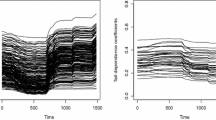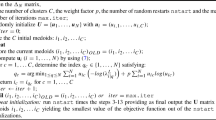Abstract
In this paper we propose a clustering procedure aimed at grouping time series with an association between extremely low values, measured by the lower tail dependence coefficient. Firstly, we estimate the coefficient using an Archimedean copula function. Then, we propose a dissimilarity measure based on tail dependence coefficients and a two-step procedure to be used with clustering algorithms which require that the objects we want to cluster have a geometric interpretation. We show how the results of the clustering applied to financial returns could be used to construct defensive portfolios reducing the effect of a simultaneous financial crisis.
Similar content being viewed by others
References
Alonso AM, Berrendero JR, Hernández A, Justel A (2006) Time series clustering based on forecast densities. Comput Stat Data Anal 51: 762–776
Baig T, Goldfajn I (1999) Financial market contagion in the Asian crisis. IMF Staff Papers 46: 167–195
Bartholomew DJ (1959) A test of homogeneity for ordered alternatives. Biometrika 38: 337–344
Bohte Z, Cepar D, Kosmelj K (1980) Clustering of time series. In: Barritt MM, Wishart D (eds) COMPSTAT 1980. In: Proceedings in computational statistics. Physica, Wien, pp 587–593
Bollerslev T, Chou R, Kroner K (1992) ARCH modeling in finance: a review of the theory and empirical evidence. J Econ 52: 5–59
Breymann W, Dias A, Embrechts P (2003) Dependence structures for multivariate high-frequency data in finance. Quant Fin 3: 1–14
Caiado J, Crato N, Peña D (2006) A periodogram-based metric for time series classification. Comput Stat Data Anal 50: 2668–2684
Cherubini U, Luciano E, Vecchiato W (2004) Copula methods in finance. Wiley, New York
Coombs CH (1964) A theory of data. Wiley, New York
Corduas M, Piccolo D (2008) Time series clustering and classification by the autoregressive metrics. Comput Stat Data Anal 52: 1860–1872
De Luca G, Rivieccio G, Zuccolotto P (2010) Combining random forest and copula functions: a heuristic approach for selecting assets from a financial crisis perspective. Int Syst Acc Fin Man 17: 91–109
D’Urso P, Maharaj EA (2009) Autocorrelation-based fuzzy clustering of time series. Fuzzy Sets Syst 160: 3565–3589
Forbes K, Rigobon R (2002) No contagion, only interdependence: measuring stock market co-movements. J Fin 57: 2223–2261
Fortin I, Kuzmics C (2002) Tail-dependence in stock-return pairs. Int J Intell Syst Acc Fin Manag 11: 89–107
Galeano P, Peña D (2006) Multivariate analysis in vector time series. Resenhas 4: 383–404
Joe H (1997) Multivariate models and dependence concepts. Chapman & Hall/CRC, New York
Kakizawa Y, Shumway RH, Taniguchi M (1998) Discrimination and clustering for multivariate time series. J Am Stat Assoc 93: 328–340
Kaufman L, Rousseaw PJ (1990) Finding groups in data. Wiley, New York
Kruskal JB (1964) Multidimensional scaling by optimizing a goodness of fit to a nonmetric hypothesis. Psychometrica 29: 1–27
Kruskal JB (1964) Nonmetric multidimensional scaling: a numerical method. Psychometrica 29: 115–129
Masson P (1999) Contagion. J Int M Fin 18: 587–602
Nelsen R (2006) An introduction to copulas. Springer, New York
Otranto E (2008) Clustering heteroskedastic time series by model-based procedures. Comput Stat Data Anal 52: 4685–4698
Pattarin F, Paterlini S, Minerva T (2004) Clustering financial time series: an application to mutual funds style analysis. Comput Stat Data Anal 47: 353–372
Patton AJ (2006) Modelling asymmetric exchange rate dependence. Int Ec Rev 47: 527–556
Piccolo D (1990) A distance measure for classifying ARMA models. J Time Ser Anal 11: 153–164
Shepard RN (1962) The analysis of proximities: multidimensional scaling with an unknown distance function-I. Psychometrica 27: 125–140
Shepard RN (1962) The analysis of proximities: multidimensional scaling with an unknown distance function-II. Psychometrica 27: 219–246
Taniguchi M, Kakizawa Y (2000) Asymptotic theory of statistical inference for time series. Springer, New York
Vilar JA, Alonso AM, Vilar JM (2010) Non-linear time series clustering based on non-parametric forecast densities. Comput Stat Data Anal 54: 2850–2865
Weng X, Shen J (2008) Classification of multivariate time series using two-dimensional singular value decomposition. Knowl Based Syst 21: 535–539
Author information
Authors and Affiliations
Corresponding author
Rights and permissions
About this article
Cite this article
De Luca, G., Zuccolotto, P. A tail dependence-based dissimilarity measure for financial time series clustering. Adv Data Anal Classif 5, 323–340 (2011). https://doi.org/10.1007/s11634-011-0098-3
Received:
Revised:
Accepted:
Published:
Issue Date:
DOI: https://doi.org/10.1007/s11634-011-0098-3




